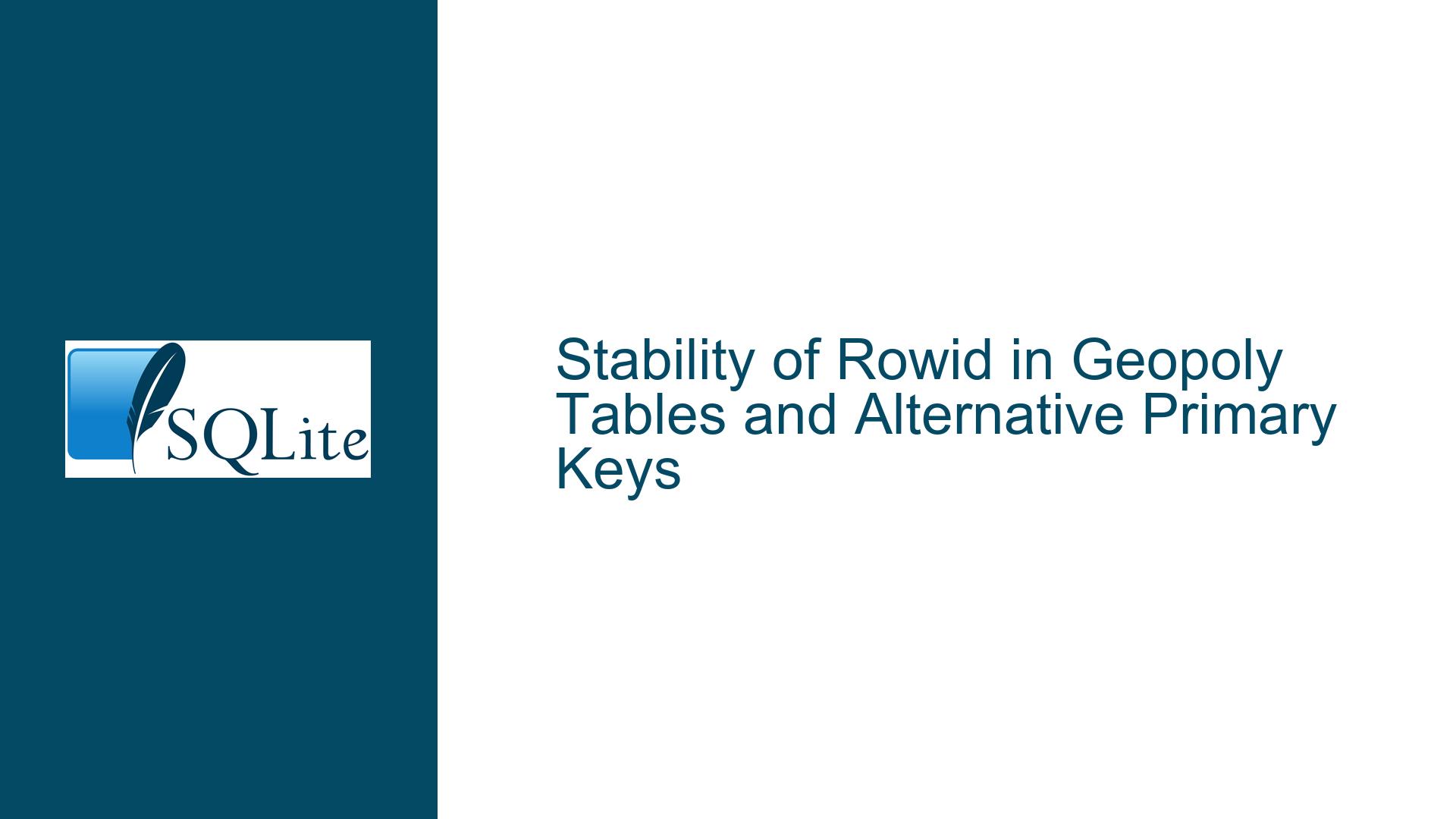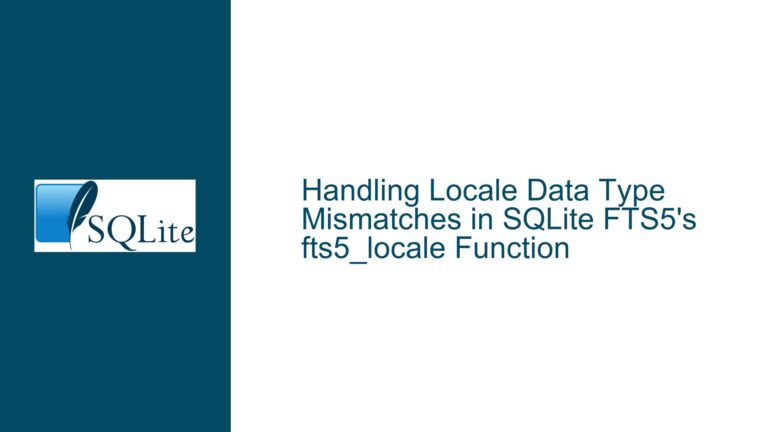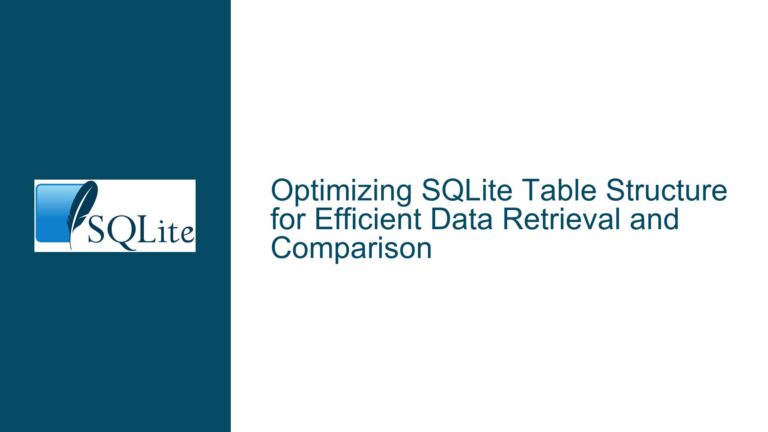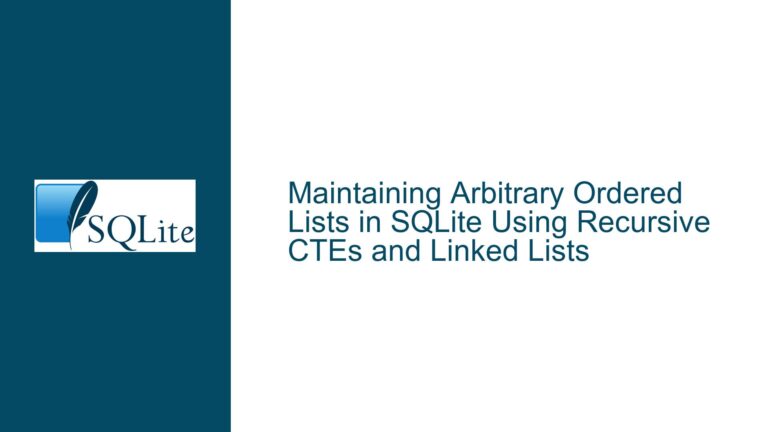Stability of Rowid in Geopoly Tables and Alternative Primary Keys
Stability of Rowid in Geopoly Tables
The core issue revolves around the stability of the rowid column in Geopoly tables within SQLite. The rowid is a built-in integer column that exists in every SQLite table, including Geopoly tables, which are specialized for storing and querying geometric polygons. In regular SQLite tables, the rowid is not guaranteed to be stable; it can change during operations like VACUUM, which reorganizes the database file to reclaim unused space. However, the behavior of rowid in Geopoly tables is less documented, leading to uncertainty about whether it can be treated as a stable identifier.
The primary concern is whether the rowid in Geopoly tables remains consistent across database operations, particularly after a VACUUM. If the rowid is stable, it can be safely used as a unique identifier for rows in the table. If not, developers need to consider alternative methods for maintaining stable identifiers, such as adding an explicit primary key column.
Possible Causes of Rowid Instability in Geopoly Tables
The instability of rowid in regular SQLite tables stems from the way SQLite manages storage. When rows are deleted, gaps are left in the storage, and a VACUUM operation can reorganize the table to fill these gaps, potentially reassigning rowid values. This behavior is well-documented for standard tables but not explicitly addressed for Geopoly tables.
Geopoly tables are implemented using a virtual table mechanism, which means they do not store data in the same way as regular tables. Instead, they use an underlying data structure optimized for geometric operations. This difference in implementation could theoretically lead to different behavior for rowid stability. For example, if the Geopoly virtual table implementation does not rely on the same storage mechanism as regular tables, it might not be affected by VACUUM operations in the same way.
Another factor to consider is whether the Geopoly module explicitly handles rowid assignment. If the module assigns rowid values independently of SQLite’s internal mechanisms, it might ensure stability even during operations that would normally cause rowid changes in regular tables. However, without explicit documentation or confirmation from the SQLite development team, this remains speculative.
Troubleshooting Steps, Solutions & Fixes for Rowid Stability in Geopoly Tables
To address the uncertainty surrounding rowid stability in Geopoly tables, developers can take several steps to ensure data integrity and stable identifiers.
Step 1: Conduct Empirical Testing
The first step is to conduct empirical tests to observe the behavior of rowid in Geopoly tables under various conditions. Create a Geopoly table and populate it with a set of polygons. Record the rowid values for each row. Perform a series of operations, including inserting new rows, deleting existing rows, and running VACUUM. After each operation, check whether the rowid values have changed. This will provide concrete evidence of whether rowid is stable in Geopoly tables.
Step 2: Review SQLite Source Code
For developers comfortable with reading C code, reviewing the SQLite source code can provide insights into how Geopoly tables handle rowid. The Geopoly module is implemented as a virtual table, and its source code is available in the SQLite repository. By examining the code, developers can determine whether rowid values are managed in a way that ensures stability. Look for functions that handle row insertion, deletion, and VACUUM operations to see if they explicitly preserve rowid values.
Step 3: Consult SQLite Documentation and Community
While the SQLite documentation does not explicitly address rowid stability in Geopoly tables, it is worth revisiting the documentation for any updates or clarifications. Additionally, reaching out to the SQLite community, such as the SQLite forum or mailing list, can provide insights from other developers who may have encountered similar issues. The SQLite development team is also responsive to questions and bug reports, so submitting a query directly to them can yield authoritative answers.
Step 4: Implement an Alternative Primary Key
If empirical testing or code review suggests that rowid is not stable in Geopoly tables, developers should consider implementing an alternative primary key. This can be done by adding an explicit integer column to the table and populating it with unique values. For example:
CREATE TABLE geopoly_table (
id INTEGER PRIMARY KEY AUTOINCREMENT,
_shape BLOB
);
In this example, the id column serves as a stable identifier for each row. Unlike rowid, the id column is explicitly managed by the developer and is not affected by VACUUM operations. This approach ensures that each row has a unique and stable identifier, even if the underlying rowid changes.
Step 5: Monitor SQLite Updates
SQLite is actively maintained, and new versions may include updates or clarifications regarding rowid stability in Geopoly tables. Developers should monitor release notes and documentation for any changes that address this issue. If the SQLite development team confirms that rowid is stable in Geopoly tables, the documentation should be updated to reflect this, providing clarity for future users.
Step 6: Use Triggers for Data Integrity
If rowid stability cannot be guaranteed, developers can use triggers to enforce data integrity. For example, a trigger can be created to log changes to rowid values, allowing developers to track and manage any unexpected changes. While this does not prevent rowid changes, it provides a mechanism for detecting and addressing them.
CREATE TRIGGER track_rowid_changes
AFTER UPDATE OF rowid ON geopoly_table
FOR EACH ROW
BEGIN
INSERT INTO rowid_changes_log (old_rowid, new_rowid, change_time)
VALUES (OLD.rowid, NEW.rowid, datetime('now'));
END;
This trigger logs any changes to rowid values in a separate table, providing a historical record that can be used for troubleshooting or data recovery.
Step 7: Consider Alternative Database Solutions
If rowid stability is critical for your application and cannot be guaranteed in SQLite, consider using an alternative database system that provides more explicit control over row identifiers. For example, PostgreSQL offers stable row identifiers through its oid or ctid columns, which are not affected by VACUUM operations. However, this approach involves significant changes to the application architecture and should only be considered if other solutions are not viable.
Conclusion
The stability of rowid in Geopoly tables is a nuanced issue that requires careful consideration and testing. While empirical evidence suggests that rowid may be stable in Geopoly tables, the lack of explicit documentation means that developers should proceed with caution. By conducting thorough testing, reviewing the SQLite source code, and implementing alternative primary keys, developers can ensure data integrity and stable identifiers in their Geopoly tables. Monitoring SQLite updates and engaging with the community can also provide valuable insights and solutions to this issue.






